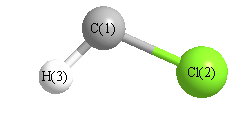Jump to
S2C1
Energy calculated at BLYP/6-311G*
| | hartrees |
|---|
| Energy at 0K | -498.770951 |
| Energy at 298.15K | -498.770779 |
| HF Energy | -498.770951 |
| Nuclear repulsion energy | 37.679105 |
The energy at 298.15K was derived from the energy at 0K
and an integrated heat capacity that used the calculated vibrational frequencies.
Geometric Data calculated at BLYP/6-311G*
Point Group is Cs
Cartesians (Å)
| Atom |
x (Å) |
y (Å) |
z (Å) |
|---|
| C1 |
0.046 |
1.230 |
0.000 |
| Cl2 |
0.046 |
-0.519 |
0.000 |
| H3 |
-1.059 |
1.441 |
0.000 |
Atom - Atom Distances (Å)
| |
C1 |
Cl2 |
H3 |
| C1 | | 1.7492 | 1.1247 |
Cl2 | 1.7492 | | 2.2498 | H3 | 1.1247 | 2.2498 | |
 More geometry information
More geometry information
Calculated Bond Angles
| atom1 |
atom2 |
atom3 |
angle |
|
atom1 |
atom2 |
atom3 |
angle |
| Cl2 |
C1 |
H3 |
100.797 |
|
Electronic energy levels
Charges, Dipole, Quadrupole and Polarizability
Charges from optimized geometry at BLYP/6-311G*
Charges (e)
| Number |
Element |
Mulliken |
CHELPG |
AIM |
ESP |
| 1 |
C |
-0.271 |
|
|
|
| 2 |
Cl |
0.060 |
|
|
|
| 3 |
H |
0.210 |
|
|
|
Electric dipole moments
Electric dipole components in Debye
(What's a Debye? See section
VII.A.3)
| |
x |
y |
z |
Total |
| |
-1.534 |
-0.530 |
0.000 |
1.623 |
| CHELPG |
|
|
|
|
| AIM |
|
|
|
|
| ESP |
|
|
|
|
Electric Quadrupole moment
Quadrupole components in D Å
| Primitive |
|---|
| | x | y | z |
|---|
| x |
-19.960 |
-2.555 |
0.000 |
| y |
-2.555 |
-20.485 |
0.000 |
| z |
0.000 |
0.000 |
-18.394 |
|
| Traceless |
|---|
| | x | y | z |
|---|
| x |
-0.520 |
-2.555 |
0.000 |
| y |
-2.555 |
-1.308 |
0.000 |
| z |
0.000 |
0.000 |
1.828 |
|
| Polar |
|---|
| 3z2-r2 | 3.657 |
|---|
| x2-y2 | 0.525 |
|---|
| xy | -2.555 |
|---|
| xz | 0.000 |
|---|
| yz | 0.000 |
|---|
|
Polarizabilities
Components of the polarizability tensor.
Units are
Å
3 (Angstrom cubed)
Change units.
| |
x |
y |
z |
| x |
2.437 |
-0.331 |
0.000 |
| y |
-0.331 |
5.206 |
0.000 |
| z |
0.000 |
0.000 |
1.836 |
<r2> (average value of r
2) Å
2
| <r2> |
29.155 |
| (<r2>)1/2 |
5.400 |
Jump to
S1C1
Energy calculated at BLYP/6-311G*
| | hartrees |
|---|
| Energy at 0K | -498.761843 |
| Energy at 298.15K | -498.761668 |
| HF Energy | -498.761843 |
| Nuclear repulsion energy | 38.408194 |
The energy at 298.15K was derived from the energy at 0K
and an integrated heat capacity that used the calculated vibrational frequencies.
Geometric Data calculated at BLYP/6-311G*
Point Group is Cs
Cartesians (Å)
| Atom |
x (Å) |
y (Å) |
z (Å) |
|---|
| C1 |
0.037 |
1.173 |
0.000 |
| Cl2 |
0.037 |
-0.520 |
0.000 |
| H3 |
-0.858 |
1.800 |
0.000 |
Atom - Atom Distances (Å)
| |
C1 |
Cl2 |
H3 |
| C1 | | 1.6927 | 1.0936 |
Cl2 | 1.6927 | | 2.4870 | H3 | 1.0936 | 2.4870 | |
 More geometry information
More geometry information
Calculated Bond Angles
| atom1 |
atom2 |
atom3 |
angle |
|
atom1 |
atom2 |
atom3 |
angle |
| Cl2 |
C1 |
H3 |
125.012 |
|
Electronic energy levels
Charges, Dipole, Quadrupole and Polarizability
Charges from optimized geometry at BLYP/6-311G*
Charges (e)
| Number |
Element |
Mulliken |
CHELPG |
AIM |
ESP |
| 1 |
C |
-0.307 |
|
|
|
| 2 |
Cl |
0.062 |
|
|
|
| 3 |
H |
0.245 |
|
|
|
Electric dipole moments
Electric dipole components in Debye
(What's a Debye? See section
VII.A.3)
| |
x |
y |
z |
Total |
| |
-0.858 |
0.240 |
0.000 |
0.891 |
| CHELPG |
|
|
|
|
| AIM |
|
|
|
|
| ESP |
|
|
|
|
Electric Quadrupole moment
Quadrupole components in D Å
| Primitive |
|---|
| | x | y | z |
|---|
| x |
-18.761 |
-1.583 |
0.000 |
| y |
-1.583 |
-17.638 |
0.000 |
| z |
0.000 |
0.000 |
-20.016 |
|
| Traceless |
|---|
| | x | y | z |
|---|
| x |
0.066 |
-1.583 |
0.000 |
| y |
-1.583 |
1.751 |
0.000 |
| z |
0.000 |
0.000 |
-1.817 |
|
| Polar |
|---|
| 3z2-r2 | -3.633 |
|---|
| x2-y2 | -1.123 |
|---|
| xy | -1.583 |
|---|
| xz | 0.000 |
|---|
| yz | 0.000 |
|---|
|
Polarizabilities
Components of the polarizability tensor.
Units are
Å
3 (Angstrom cubed)
Change units.
| |
x |
y |
z |
| x |
1.962 |
-0.186 |
0.000 |
| y |
-0.186 |
4.890 |
0.000 |
| z |
0.000 |
0.000 |
1.593 |
<r2> (average value of r
2) Å
2
| <r2> |
28.603 |
| (<r2>)1/2 |
5.348 |
